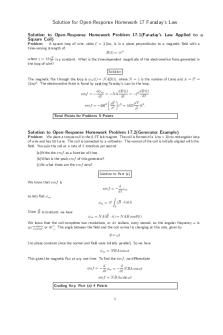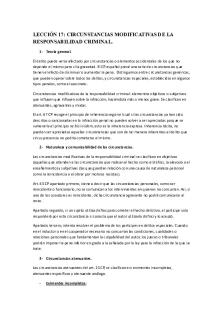Solution OR Hwk (17) - OR HW 17 PDF

| Title | Solution OR Hwk (17) - OR HW 17 |
|---|---|
| Course | University Physics Ii |
| Institution | University of Arkansas |
| Pages | 4 |
| File Size | 142.6 KB |
| File Type | |
| Total Downloads | 89 |
| Total Views | 151 |
Summary
OR HW 17...
Description
Solution for Open-Response Homework 17 Faraday’s Law Solution to Open-Response Homework Problem 17.1(Faraday’s Law Applied to a Square Coil) Problem: A square loop of wire, sides ℓ = 3.0m, is in a plane perpendicular to a magnetic field with a time-varying strength of B(t) = γt4 where γ = 12 µT is a constant. What is the time-dependent magnitude of the electromotive force generated in s4 the loop of wire? Solution The magnetic flux through the loop is φm (t) = N AB (t), where N = 1 is the number of turns and A = ℓ2 = (3m)2 . The electromotive force is found by applying Faraday’s Law to the loop, dB(t) dB(t) dφm = −ℓ2 = −N A dt dt dt ¾ ½ µV µT 3 t = (432 3 )t3 . emf = −48ℓ2 s4 s
emf = −
Total Points for Problem: 5 Points
Solution to Open-Response Homework Problem 17.2(Generator Example) Problem: We place a torque coil in the 0.2T lab magnet. The coil is formed of a 1cm × 10cm rectangular loop of wire and has 50 turns. The coil is connected to a voltmeter. The normal of the coil is initially aligned with the field. You spin the coil at a rate of 2 rotations per second. (a)Write the emf as a function of time. (b)What is the peak emf of this generator? (c)At what times are the emf zero? Solution to Part (a) We know that emf is emf = −
d φm dt
so lets find φm . φm = N
Z
~ ·n ˆ )dA (B
S
~ is constant, we have Since B
~ ·n φm = N A(B ˆ ) = N AB cos θ(t)
We know that the coil completes two revolutions, or 4π radians, every second, so the angular frequency ω is or 4π s1 . The angle between the field and the coil normal is changing at this rate, given by 4π radians second θ = ωt (no phase constant since the normal and field were initially parallel). So we have φm = N BA cos ωt This gives the magnetic flux at any one time. To find the emf , we differentiate emf = −
d d φm = − N BA cos ωt dt dt
emf = N BAω sin ωt Grading Key: Part (a) 4 Points
1
Solution to Part (b) The peak emf will occur when the coil normal and the magnetic field are perpendicular (this is when there is the most change in flux), or when | sin θ| = 1, which will first occur at t = 18 s. So we will have emfpeak = N BAω emfpeak = (50)(0.2T)(1cm × 10cm)(4πs−1 ) = 0.126V Grading Key: Part (b) 2 Points Solution to Part (c) The emf will be zero any time sin θ is zero. This will occur when θ = nπ (where n is a non-negative integer). And so θ = ωt = nπ n nπ = s t= 4 4π 1s emf will first be zero at t = 0 and then at every quarter of a second after that. Grading Key: Part (c) 2 Points Total Points for Problem: 8 Points
Solution to Open-Response Homework Problem 17.3(Roller Coaster) Problem: A roller coaster uses magnetic braking in order to slow down the fast moving car before it re-enters the station. It also uses magnetic detectors to track the car. One of the detectors is attached to the bottom of the car is a rectangular copper coil with 15 turns of dimensions w = 20cm by l = 100cm. It is attached so that the short end points down the track and the long end is parallel with the track. Fixed to the track before the station is a strong magnet which produces a fairly uniform magnetic field of B0 = 3T perpendicular to the coil. The car enters the part of the track with the magnet travelling with a speed of 13 m s . The system is illustrated below at the point when the coil enters the field and the point when it leaves the field. (a)Compute the magnetic flux as a function of time as the coil enters the field of the magnet, before it completely enters the field. Report a symbolic answer. (b)Compute the emf through the coil as it enters the field of the magnet. Report both a symbolic and numeric value. (c)Is the direction of the induced current on the drawing below clockwise or counterclockwise as the coil enters the magnet’s field? What about as it leaves the magnet’s field? (d)What is the name of the physical law that relates the changing flux to the emf ?
Entering Magnet
Leaving Magnet
v
w
v
l
2
Solution to Part(a) Since the normal to the coil is parallel to the magnetic field, the magnetic flux becomes Z ~ ·n φm (t) = N ( B ˆ )dA = N BA(t) S
where A(t) is the amount of the coil that is in the field, A(t) = wℓ(t) = wvt and the magnetic flux is φm (t) = N Bwvt until the coil fully enters the magnet. Grading Key: Solution to Part (a) 4 Points Solution to Part(b) The emf around the loop due to the changing flux is, by Faraday’s Law, emf = − Now substituting,
d dφm = − N Bwvt = −N Bwv dt dt
³ m´ emf = −(15)(−3T)(0.20m) 13 = 117V s
Grading Key: Solution to Part (b) 3 Points Solution to Part(c) (a) Entering the Field: The induced current acts to create a magnetic field that opposes the change in magnetic flux. Flux through the coil is increasing into the page, so the induced flux will be out of the page to partially cancel the increasing flux. The field of induced current circles the coil and must point out of the page inside the coil. An example of this field has been drawn at the bottom of the loop. The right hand rule for a wire gives the direction drawn, counterclockwise.
Entering Magnet
Leaving Magnet
v
v
(b) Exiting the field: The induced current acts to create a magnetic field that opposes the change in magnetic flux. Flux through the coil is decreasing into the page, so the induced flux will be into the page to partially cancel the decreasing flux. The field of induced current circles the coil and must point into the page inside the coil. An example of this field has been drawn at the bottom of the loop. The right hand rule for a wire gives the direction drawn, clockwise. 3
Grading Key: Solution to Part (c) 4 Points Solution to Part(d) Faraday’s Law. Qualitatively, Faraday’s Law states that if the magnetic flux through a closed path is changing, there is an emf induced around the path; the faster the flux changes, the larger the emf. emf =
dφm dt
Grading Key: Solution to Part (d) 1 Points Total Points for Problem: 12 Points
4...
Similar Free PDFs

Solution OR Hwk (17) - OR HW 17
- 4 Pages

HW #17 - lol
- 2 Pages

Solution MC Hwk (20) - MC HW 20
- 5 Pages

Solution MC Hwk (14) - MC HW 14
- 7 Pages

Solution MC Hwk (8) - MC HW 8
- 8 Pages

17 Harley-Davidson solution
- 18 Pages

WEEK- 13-HW- Chapter 17
- 9 Pages

17 - Chapter 17
- 23 Pages

Tema 17 - Apuntes 17
- 6 Pages

TEMA 17 - Apuntes 17
- 9 Pages

SBOB Anatomia 17 - Appunti 17
- 17 Pages

Lezione 17 - ospite - Appunti 17
- 5 Pages

LecciÓn 17 - Lecture notes 17
- 6 Pages

Chapter 17 - Lecture notes 17
- 15 Pages

Ungraded HW Solutions for April 17
- 10 Pages

17. 30-05 - Appunti 17
- 13 Pages
Popular Institutions
- Tinajero National High School - Annex
- Politeknik Caltex Riau
- Yokohama City University
- SGT University
- University of Al-Qadisiyah
- Divine Word College of Vigan
- Techniek College Rotterdam
- Universidade de Santiago
- Universiti Teknologi MARA Cawangan Johor Kampus Pasir Gudang
- Poltekkes Kemenkes Yogyakarta
- Baguio City National High School
- Colegio san marcos
- preparatoria uno
- Centro de Bachillerato Tecnológico Industrial y de Servicios No. 107
- Dalian Maritime University
- Quang Trung Secondary School
- Colegio Tecnológico en Informática
- Corporación Regional de Educación Superior
- Grupo CEDVA
- Dar Al Uloom University
- Centro de Estudios Preuniversitarios de la Universidad Nacional de Ingeniería
- 上智大学
- Aakash International School, Nuna Majara
- San Felipe Neri Catholic School
- Kang Chiao International School - New Taipei City
- Misamis Occidental National High School
- Institución Educativa Escuela Normal Juan Ladrilleros
- Kolehiyo ng Pantukan
- Batanes State College
- Instituto Continental
- Sekolah Menengah Kejuruan Kesehatan Kaltara (Tarakan)
- Colegio de La Inmaculada Concepcion - Cebu